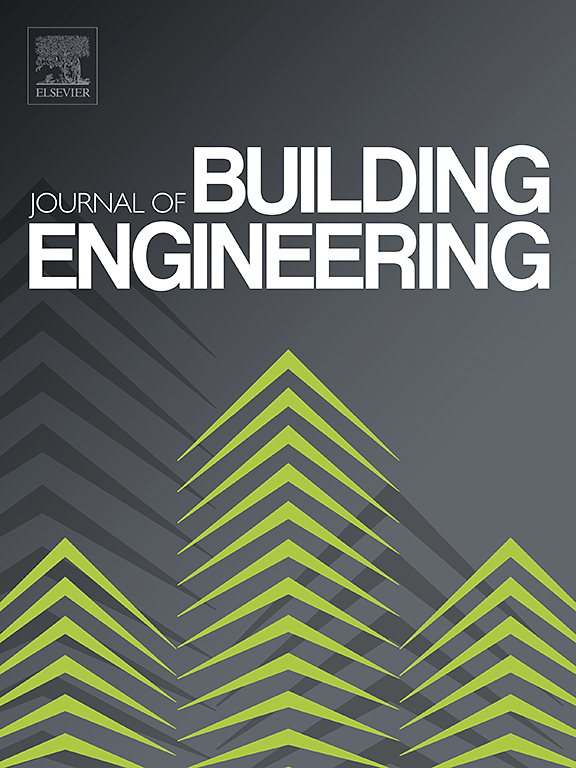火灾-结构耦合模拟中的隔热材料热解模型
IF 6.7
2区 工程技术
Q1 CONSTRUCTION & BUILDING TECHNOLOGY
引用次数: 0
摘要
本文提出了一种建模方法,用于预测带有一层隔热材料的结构在火灾下的热力学和热机械行为,其中考虑到了隔热材料的热解及其对结构的影响。首先,实施现有的一维热解模型,并通过理论验证和实验结果验证。然后,将模型的一维设置集成到结构的三维传热(HT)分析中。获得的热力学结果,即温度与时间和热解过程的函数关系,被转移到热力学结构响应(SR)分析中。然后通过温度和热解相关材料特性获得力学结果。由此产生的 HT 和 SR 分析结果在夹芯板外墙的防火结构模拟中进行了演示,包括用非线性弹簧元件建模的钢结构支撑框架、螺栓和螺钉连接。结果表明,在 100 秒的短时间窗口内,热解仅限于面板的某些区域和有限深度。然而,由于热解过程是一个内热过程,它减少了面板的膨胀和弯曲,从而导致较小的位移和延迟连接失效。在忽略连接失效的情况下,如果时间较长,则会发生明显的热解,从而影响整个夹芯板内部的温度分布。不过,这对结构行为的影响微乎其微。总之,热解效应是相关的,可以模拟,并可在一定程度上降低结构的火灾风险。未来的研究可采用双尺度方法,将热解与螺栓和螺钉连接的高级建模结合起来。这样,就可以对结构的所有相关细节进行建模,并针对不同的火灾情况进行研究,包括火灾对结构的影响,所有这些仍有待实验验证。本文章由计算机程序翻译,如有差异,请以英文原文为准。
Pyrolysis modelling of insulation material in coupled fire-structure simulations
This paper presents a modelling approach to predict the thermodynamical and thermomechanical behaviour of structures with a layer of insulation material under fire, which takes into account the pyrolysis of the insulation and its effects on the structure. First, an existing 1D pyrolysis model is implemented and verified by theoretical and validated by experimental results. Then the model’s 1D setup is integrated into 3D Heat Transfer (HT) analyses of structures. The obtained thermodynamical results, i.e. temperatures as a function of time and the pyrolysis process, are transferred to a thermomechanical Structural Response (SR) analysis. Mechanical results are then obtained via temperature and pyrolysis-dependent material properties. The resulting HT and SR analyses are demonstrated in fire-structure simulations of facades made of sandwich panels, including their supporting frames with steel sections, and bolt and screw connections, modelled by non-linear spring elements. It is shown that in a short time window of 100 s, pyrolysis is limited to certain zones of the panel and for limited depths. Nevertheless, due to the endothermic process, it reduces expansion and bending of the panels, and consequently results in smaller displacements, and delayed failure of the connections. For longer periods, with connection failures neglected, significant pyrolysis takes place, which influences the temperature distribution in the complete interior of the sandwich panel. However, this has only a marginal effect on the structural behaviour. In conclusion, pyrolysis effects are relevant, can be modelled, and may somewhat reduce fire risks in structures. Future research can combine pyrolysis with advanced modelling of bolt and screw connections, using a two-scale method. As such, all relevant details of structures can be modelled and investigated for different fire scenarios, including fire-structure effects, all still to be validated by experiments.
求助全文
通过发布文献求助,成功后即可免费获取论文全文。
去求助
来源期刊

Journal of building engineering
Engineering-Civil and Structural Engineering
CiteScore
10.00
自引率
12.50%
发文量
1901
审稿时长
35 days
期刊介绍:
The Journal of Building Engineering is an interdisciplinary journal that covers all aspects of science and technology concerned with the whole life cycle of the built environment; from the design phase through to construction, operation, performance, maintenance and its deterioration.
 求助内容:
求助内容: 应助结果提醒方式:
应助结果提醒方式:


